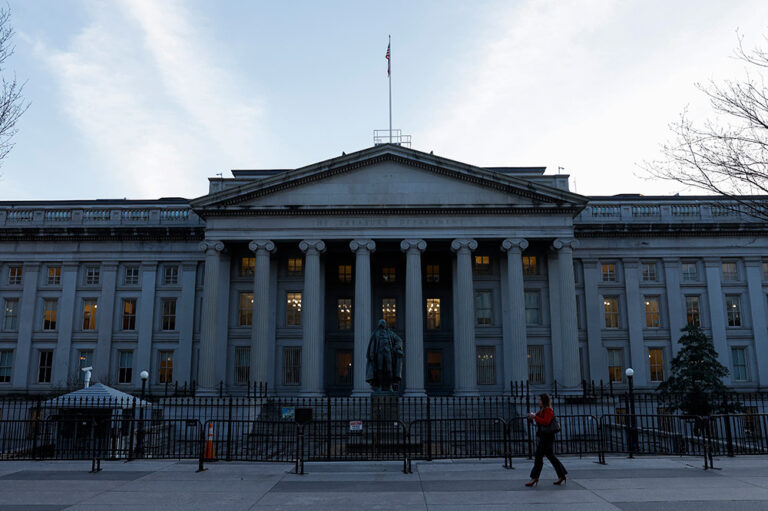In fiscal year 2024 (FY24), which ended on September 30, 2024, the federal government ran a budget deficit of $1.8 trillion. That’s an increase of $138 billion — or about 8 percent — higher than the previous year’s official deficit. Let’s look at the factors driving the deficit and why it increased last year.
Revenues Are Up — but So Is Spending
Though the federal budget can be very complex, the story of the rising deficit can be summed up rather simply: revenues were up, but so was spending.
Revenues in FY24 were $4.9 trillion in total — $479 billion above the amount collected in FY23 (an 11 percent increase). Most of that increase stems from individual income and payroll taxes, which were $345 billion (9 percent) above the previous year’s level. A few factors contributed to the growth:
- An increase in amounts withheld from paychecks, reflecting wage and salary growth.
- An increase in nonwithheld tax payments, primarily because of the postponement of tax payments for those affected by natural disasters.
- A decline in individual income tax refunds of $74 billion (20 percent). Part of that decrease stems from the moratorium put in place last year on the Employee Retention Tax Credit by the Internal Revenue Service due to concerns about fraud and abuse. The agency has since begun processing claims again with greater scrutiny.
The other major contributor to revenue growth in 2024 was from payments of corporate income taxes, which were up by $110 billion (26 percent) — partly due to the postponement of tax deadlines related to natural disasters.
Looking at the other side of the budget ledger, spending in FY24 was $6.8 trillion — $617 billion higher than the previous year’s total. The main driver of the underlying growth in outlays was an increase of $222 billion in net interest costs (34 percent), primarily due to higher interest rates and increased borrowing. Other categories that saw significant growth in outlays were Social Security ($107 billion), Medicare ($79 billion), and defense spending ($53 billion).
The most significant decrease in outlays was $55 billion by the Federal Deposit Insurance Corporation (FDIC), which recorded outlays of $92 billion in FY23, mainly due to the failure of First Republic Bank. Additionally, outlays from tax credits related to the government's response to the COVID-19 pandemic decreased by $51 billion as programs continued to expire. Other categories of outlays that decreased include spending by the Pension Benefit Guaranty Corporation because certain one-time payments were made to pension plans in FY23 but not in FY24 ($28 billion) and spending related to the Supplemental Nutrition Assistance Program ($28 billion).
Accounting Adjustments
Beyond those big-picture trends, fully understanding the deficit story for the past couple of years requires a review of a series of accounting adjustments for the federal budget. In FY22, the Department of the Treasury recorded a deficit of nearly $1.4 trillion for the year; that total included a “cost” of $379 billion to account for the Administration’s plan for student loan forgiveness. Without that adjustment, the deficit for FY22 would have been around $1 trillion.
However, in July 2023, the Supreme Court struck down the plan for debt forgiveness; as a result, a $330 billion reduction in spending was recorded (the amount of the reduction was less than the amount of cost recorded the previous year because the cost of other provisions in FY23 offset a portion of the reduction). Without that adjustment, the deficit for FY23 would have totaled around $2 trillion.
In addition to the student loan adjustment, FY23 and FY24 experienced another accounting adjustment that affected the reported deficit in both fiscal years. October 1 fell on a weekend in both 2022 and 2023, causing certain payments to be paid in advance, which shifted outlays into the prior fiscal year. The FY23 impact was modest, decreasing the deficit by only $9 billion on net. The FY24 effect was more significant; including adjustments for timing shifts, the underlying deficit in FY24 was $1.9 trillion, which was $72 billion higher than the reported deficit.
Considering those adjustments reveals that the underlying deficit decreased year-over-year; nevertheless, the deficit remains unsustainably high.
Conclusion
Despite a healthy economy driving revenues higher, the underlying deficit nearly reached $2 trillion for the second year in a row. What’s more, annual deficits will likely remain at or exceed $2 trillion over the next decade (and beyond) if current laws stay the same. While accounting quirks may have made the bottom line appear slightly better, the need for reform remains. As the United States enters a new fiscal year, policymakers should focus on finding solutions to the structural issues that threaten the nation’s economic strength and preparedness in the years to come.
Image credit: weible1980/Getty Images
Further Reading
The Fed Reduced the Short-Term Rate Again, but Interest Costs Remain High
High interest rates on U.S. Treasury securities increase the federal government’s borrowing costs.
What Types of Securities Does the Treasury Issue?
Let’s take a closer look at a few key characteristics of Treasury borrowing that can affect its budgetary cost.
Quarterly Treasury Refunding Statement: Borrowing Up Year Over Year
Key highlights from the most recent Quarterly Refunding include an increase in anticipated borrowing of $158 billion compared to the same period in the previous year.


